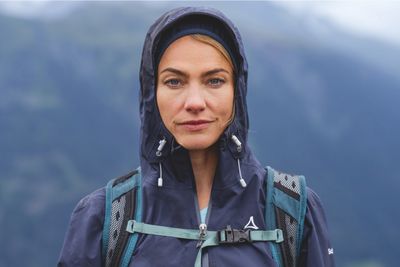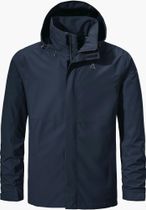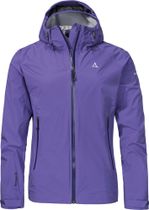Contents
- What is a water column rating?
- Waterproof, water-repellent, or water-resistant?
- Two jackets, two approaches: Schöffel in comparison
- Schöffel jacket Gmund: rugged all-rounder
- Schöffel 2.5L 3D jacket Vistdal: lightweight for demanding conditions
- What to look for when buying
- Your water column questions—clearly answered
Understanding water column ratings: how waterproof is your jacket?
If you want to stay dry on your next outdoor adventure, there’s more to consider than just color and fit when buying a jacket. One often-mentioned yet rarely explained term plays a key role: the water column. But what exactly does it mean—and how much is enough for your activity?
What is a water column rating?
Imagine placing a pipe vertically on your jacket material and filling it with water. The water column rating tells you how high the water can rise in this pipe before it starts to seep through the fabric.
This is measured in millimeters: 1,000 mm is roughly the pressure of light rain, while 10,000 mm and above means your jacket will keep you dry even in heavy downpours. Legally, materials with 1,300 mm or more can be called "waterproof," but for outdoor use, that’s usually not sufficient.
>> Discover high-quality rain jackets for your outdoor adventures
Waterproof, water-repellent, or water-resistant?

Water-repellent means the material can withstand light showers or drizzle—but that’s about it.
Water-resistant offers a bit more protection but still isn’t fully waterproof.
Waterproof means that even in sustained heavy rain, no water will penetrate—provided the jacket has at least a 10,000 mm rating.
Although 1,300 mm qualifies as waterproof by law, real-world outdoor use often demands much more.
Depending on the activity, your water column requirements will vary:
- Hiking & everyday use: 5,000 to 15,000 mm
- Cycling: 8,000 to 20,000 mm
- Mountaineering & trekking: 10,000 to 20,000+ mm
- Skiing: 10,000 to 20,000 mm
Two jackets, two approaches: Schöffel in comparison
Schöffel jacket Gmund: rugged all-rounder
The Schöffel Gmund jacket offers a solid 10,000 mm rating, making it a reliable choice for hiking, city strolls, or commuting. Its integrated VENTURI® membrane provides not only waterproofing but also breathability, rated at 10,000 g/m²/24h.
Convenient features include a stowable hood, adjustable cuffs and hem. At around 470–500 g, it's sturdy without being heavy—ideal from spring to fall.
Schöffel 2.5L 3D jacket Vistdal: lightweight for demanding conditions
For those heading into alpine terrain or dealing with unpredictable weather, the Schöffel Vistdal 2.5L 3D jacket is a high-tech alternative. Its Dermizax® membrane boasts 20,000 mm waterproofing and the same level of breathability. Despite these top specs, it weighs only about 240 g and packs down easily.
Eco-friendly ecodear™ nylon, a PFC-free water-repellent finish, and an adjustable hood complete the package—ideal for performance-oriented use in wind and rain.




What to look for when buying

A high rating is only part of the picture. The overall design quality plays a major role. Look for sealed or taped seams—water always finds the weakest point.
Even the best rating won’t help if the seams are poorly finished. Material choice is also key: durable ripstop fabrics withstand wear and tear longer, while stretch elements improve freedom of movement.
An adjustable hood and hem add protection against water and wind. And don’t forget breathability—because if you’re sweating on a climb, you don’t want to get soaked from the inside out.
>> Complete your rain protection with waterproof and water-repellent pants
Your water column questions—clearly answered
How does the water column help me choose a rain jacket?
When is a jacket truly waterproof?
What does the water column say about a jacket’s quality?
Is a higher water column always better?
How do I find the right rain jacket for my activity?
What’s the difference between a membrane and a coating?


